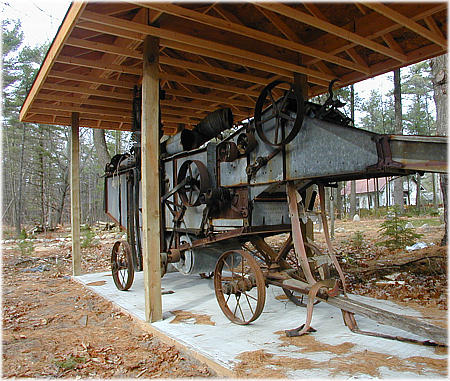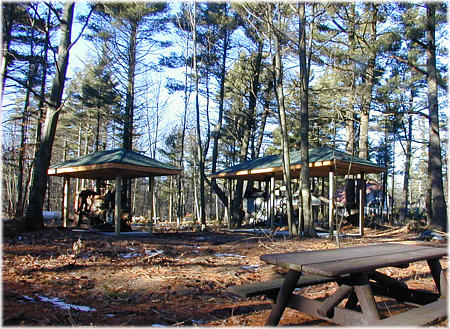|
Heritage Park
Last winter our intent was to concentrate on Heritage Park this spring, and to hopefully erect a third display--a replica sawmill had been suggested, using donated parts from various old sawmills around the Island. We made a lot of progress with this property, but we did not get quite this far. When we took a close look at the grounds, it was apparent that we should finish the clean-up before placing any more exhibits. There were artifacts scattered around, debris everywhere, caches of old bottles, dead limbs hanging in the trees, severe depressions and low spots, long grass, and a tangle of brush. We felt that if we didn't render the grounds more orderly, we might make a mistake in placing further displays, one that would not become obvious until later. So we began a lengthy and delicate process designed to let us see the landscape more clearly. Using two men hired at $12/hour, the artifacts were carried, waddled, or dragged to the property's west edge, the lumber was stacked alongside the barn, the sign board was moved out of sight, the old bottles were picked up and put in cardboard boxes and stacked in the barn, and the other piles of junk were shoveled into a wheelbarrow and loaded into a truck. Brush was carefully cut down, leaves were raked up, and a tree-trimmer was hired to cut the dead limbs from many of the trees. So far, 41 full truck loads have been deposited at the Transfer Station.
With the bike path, driveways, and roads being asphalted this spring, we wondered if it might be a good time to get an inexpensive price on putting in a parking lot. We talked over the possibility with Township Engineer Gary Vogt, explaining our limited funds. He understood our situation, and made us an offer we could not turn down: he'd get it done at no cost to us. The only catch was, we had to act quickly. We laid out a four-car area, 20' x 60', separated from the bike path by a patch of greenery. We asked Board member Ernie Martin to deliver six loads of gravel after scraping the surface of the proposed lot, bunk up the topsoil so we could use it elsewhere on the property, and then spread the fill on both the lot and in the major depressions. The Hotchkiss and Douma crew finished leveling the subgrade, even bringing in some special dense gravel before applying the asphalt. Then we hired Greg Cary to use his Bobcat to do most of the remaining moving of dirt, although almost a week of hand labor was required to finish. We rushed to get Heritage Park ready for the ceremonial opening of the bike path at 11:30 a.m. on July 4th. We erected a temporary sign of welcome on our sandwich board. Also, on the 3rd, Ed McCauley, Rod Nackerman, Rod's son Mike and his nephew Mark, and Director Bill Cashman borrowed Raymond Cole's trailer and went to the Bluebird to retrieve the side-dispensing harvester donated by Maryann Weaver. It was bigger than the trailer, but they managed to get it on just as it started to rain. Feeling lucky, the group drove to Heritage Park, where it became obvious they would have to get wet to unload the artifact. Once they got wet they decided they might as well go back to Sloptown Road to retrieve the implements offered by Al Hunting Jr, a plow, seeder, and mower, which they did. So all four artifacts were sitting in the park when the crowd gathered the next day to commemorate the bike trail. After the Fourth a little more time was spent spraying the vast grove of poison ivy and removing the final loads of debris. Some of the trees were mulched; gravel was added around the slabs so that they didn't rise up above the grade; and grass seed was scattered on some of the freshly sculpted areas to protect against erosion. All this work has not been cheap. Including the equipment work and Transfer Station fees, we have spent about $4,000 on this project this spring.
Jim Wojan, through Rod Nackerman and Don Cole, offered to donate the first road grader to be used on Beaver Island to the BIHS--so long as we put it under a roof. So now we know what the next big project at the Park is likely to be. From the Beaver Island Historical Society's Fall 2001 Newsletter: Heritage Park: Launched at Last It wasn't easy. When the farmers put up their new machine for the winter in the early 50s after its first year of work, a small barn was built over it to protect it from the weather. Over the years this structure collapsed, and was only kept from falling by the thresher itself. So the project had to begin by taking down what was left of the barn, which was done by Rod Nackerman and Ivan Young during the summer.
Before it could be moved, though, the location for it had to be determined. After Ernie Martin graded the area, many ideas were advanced, and a tentative position was staked out in August. Then Ken Bruland offered some good suggestions, which led to the final determination. Corner posts were set in cement, and Greg Cary took a break from building our sidewalks to bring over five yards of concrete at his cost. Once the concrete cured, we were ready to move the 6'-wide, 24'-long, and 10'-high behemoth. The axles for the metal wheels had plenty of grease, but no one knew if she could be pulled out of the 6"-deep holes that had formed under the wheels. A crew was assembled: Ivan, John Runberg, Ernie Martin, Joe McDonough, Alvin LaFreniere, and Bill Cashman. After positioning his trailer on the access road, Ernie was able to tow the thresher to behind it. Then three chains linked together were sufficient to tow the machine onto the trailer. She came into town with all her dignity intact. Then the challenge was to back the trailer over the rough ground and through the obstacle course to the slab. Ivan's experience moving jumbo airplanes allowed him to guide Ernie to the perfect spot, from which the thresher was gently rolled down the trailer's ramp onto its slab. Rich Gillespie and Roland Cull moved the generator onto its slab. Great Lakes Energy awarded us a $2,000 Grant from their People Fund for the materials for roofs over the first two exhibits (see the next page for a cost breakdown.) Jeff Powers cut his price so we could fit our plans into our budget. Construction began in mid-October. The first roof was completed by the end of the month, except for the shingling, which was done in early November by Robert Cole and Mark Tenser. The second, easier roof (for the First Generator) will be started soon.
| ||

